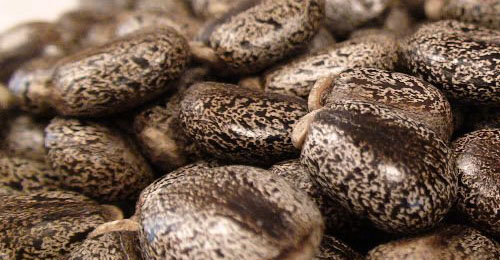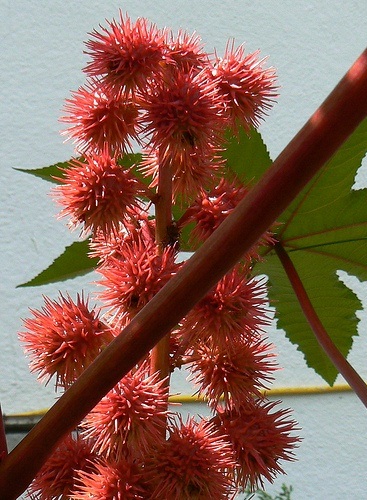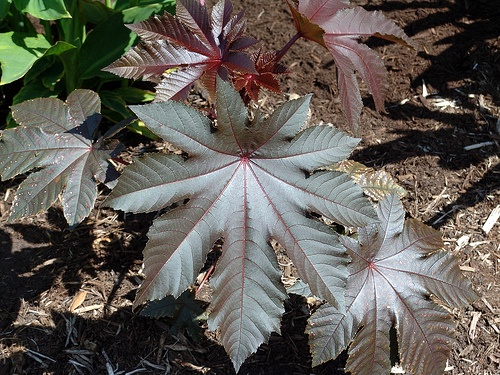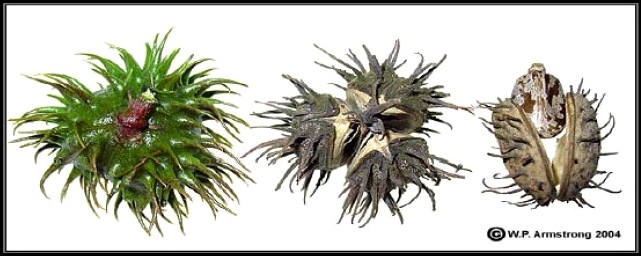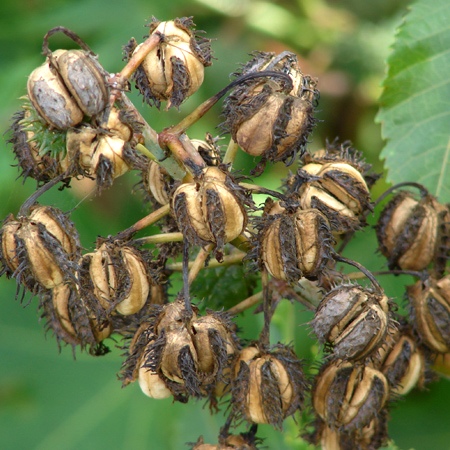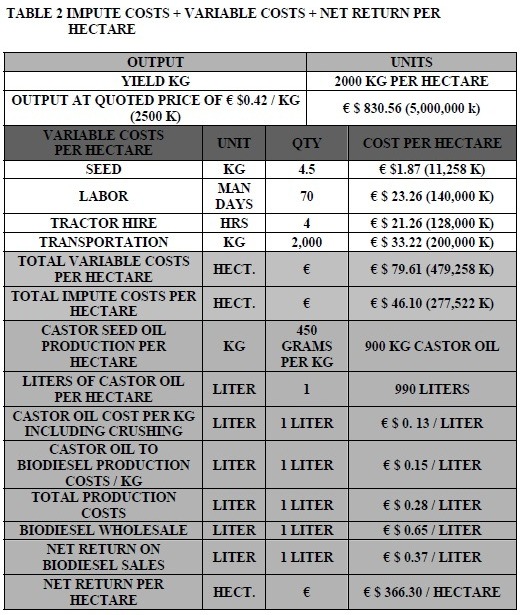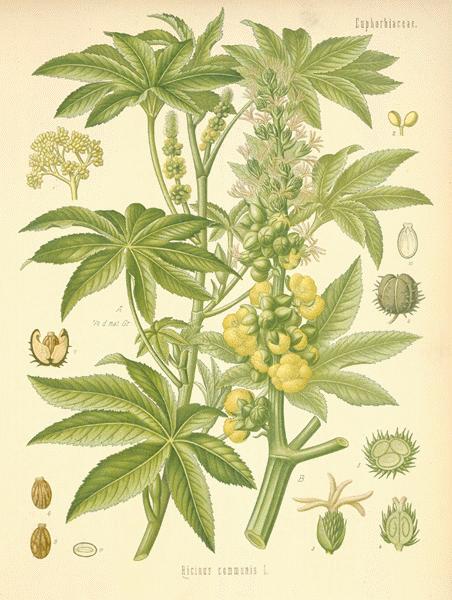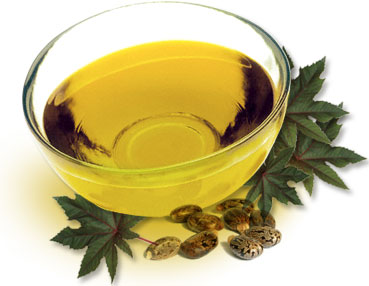Ricinus Communis
Yields
Castor (Ricinus Communis) yields as much as 350-650 kg of oil per hectare in arid and semi-arid regions when no maintenance is applied to the crop i.e. fertilizers/irrigation etc, to a high end yield where annual rainfalls happen at the right times, increasing to 1000 liters per hectare. Castor Beans have an oil content of approximately 50%. It should be noted that these production figures are without any form of commercialization i.e. fertilizers and any form of irrigation. As an example, in July 2007, Indian castor oil sold for about US$0.90 per kilogram (US$0.41 per pound) while U.S. soybean, sunflower and canola oil sold for about US$0.30 per kilogram (US$0.14 per pound).
Castor bean plants can exhaust the soil quickly, and regular fertilization is needed for continuous production of seed. Under irrigation, experimental tests in the U.S, yields from castor plants exceeded 1,000kg ha (890 lbs. ac) of seed regularly, and in Brazil yields up to 5,000 kg ha(4,450 lbs ac). Although there is potential for very high oil yield from castor bean, the fact it is considered a weed by many agricultural producers certainly limits its viability as an option to produce significant amounts of biodiesel.
 Carbon Capture
Carbon Capture
An unintended but important advantage to a castor bean project is that the plants absorb carbon dioxide, thereby reducing greenhouse gas accumulations in the atmosphere. The estimated carbon dioxide absorption level of castor bean plants is 34.6 tonnes per hectare, with two growing cycles per year, which offers another avenue for revenue in the form of carbon tax credits.
Uses
The oil extracted from the castor bean (Ricinus Communis) already has a growing international market, assured by more than 700 uses, ranging from medicines and cosmetics to substituting petroleum in the manufacturing of Biodiesel, plastics and lubricants.
Description
This robust shrub-like plant with reddish to purple stems may reach 12 feet in height and the umbrella-like leaves have 5 to 9 pointed, finger-like lobes. Long purple leaf-stems are attached near the centers of the leaf blades. Greenish-white or reddish-brown flowers are produced in narrow, upright clusters. The fruit is a three-lobed, green or red capsule with a soft, spiny exterior. One seed develops in each lobe.
The seeds of the different cultivated varieties differ in size and in external markings but average seeds are oval with a shining, marble-grey and brown brittle coat. The plant has also been bred to mature at a shorter height. Whereas the castor-oil plant traditionally reaches three meters in height, making mechanized harvest difficult, there are now varieties that grow to just 1.7 meters. These short varieties are mostly grown in Europe.It’s toxicity is sensed by animals and therefore not foraged on.
Distribution
Castor beans grow best where temperatures remain fairly high throughout the growing season of 140 to 180 days. The soil must be able to warm up early in the spring. The seed may fail to set, however, if the temperature stays above 100°F for an extended period. Viability It requires only moderate rainfall (approx. 600mm only) and can withstand long periods of drought, but will thrive under higher rainfall.
Planting
Highest yields of castor are produced under irrigation on fine or medium textured soils, and where low relative humidity prevails. Areas where soils are infested with the cotton root-rot fungus should not be considered for growing castor, because the plants are highly susceptible to this disease (Brigham and Spears 1961). At least a 140-day growing season is required to produce satisfactory yields of castor seed, and a 150 to 160-day season is more desirable.
In arid and semi-arid regions the actual growing season to first harvest may be increased to 170 days. Seedbed preparation is similar to cotton, maize, sorghum, soybean, and other row crops.
Castor Seed Project Set-Up Costs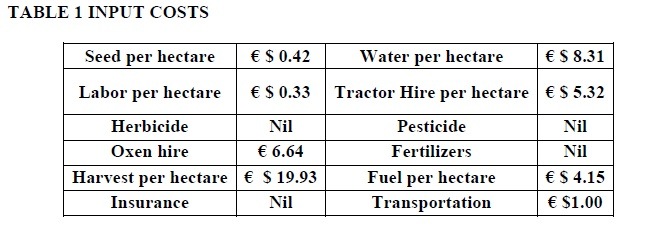
Castor bean should be planted when the soil is warm–a 10 day average of 15.6°C at 20 cm depth. Only seed of high germination and of good quality should be planted to assure timely emergence and adequate plant populations. Making use of local or indigenous species will increase not only production levels, but will also avoid potential crops being host to pests, as the local or indigenous varieties have developed locally and are therefore not prone to various diseases and pests.
Castor seeds are large and slow to germinate; emergence of the seedlings may take 7 to 14 days. Seedlings will emerge 10 to 21 days after planting. Commercial varieties grow to a height of 3 to 10 ft. The lower spikes on the plant mature first, followed by the upper spikes. Each spike bears 15 to 80 capsules, which may be prickly or smooth on the outer surface. The capsules, which develop from the female flowers, contain three seeds each and explode when ripe. Seeds vary in size, but most commercial varieties average 1,000 to 1,500 seeds/lb.
Seeds should be planted 6.3 to 7.6 cm deep, depending on texture and condition of the soil. If press wheels are used in contact with the seed, care should be taken that they do not crush the seed. Castor is planted in 0.96 to 1.01 m rows, with a seeding rate of 11.2 to 15.7 kg/ha and plant spacing of 20 to 25 cm within the row. Special care must be taken to prevent crushing the fragile seed in the planter box. Air planters are ideal, and can space seeds precisely. Deep tillage, such as chiseling 20 to 30 cm deep, encourages development and deeper penetration of the tap root. Beds usually are irrigated before planting by running water down the furrows. Planters using metering plates will require plates with proper cell size. Always check the planting unit to ensure that excessive bean cracking or crushing is not occurring during planting. Good stands of castor beans require fairly heavy planting rates, because germination of the seed is usually rather low.
Under normal conditions, 12 to 14 days between irrigations should keep plants from stressing for moisture, but high temperatures and high winds during the peak growing and fruiting periods may cause the plants to need more frequent irrigation. Castor requires 20.6 to 24.7 cm/ha of water annually to produce high yields.
Fertilizing
Cultivation is much the same as for controlling weeds in cotton or soybeans. Rotary hoes are often used before or after the plants emerge to control small annual weeds and grasses. Adequate amounts of nitrogen, phosphorus, and potassium must be available to produce high yields of castor seed. Levels of these nutrients should be determined by soil test. If the soil is deficient in nitrogen, 90 to 135 kg/ha of nitrogen usually are needed for maximum yields. A split application of nitrogen is often used, with the second half side dressed between the rows at last cultivation. If phosphorus is needed, application should be made before planting time. Potassium can be applied at planting time. A minimum of 37 to 56 kg/ha of P is needed for production of castor, and 15 to 19 kg/ha of K.
Harvesting
The castor bean crop is ready for harvesting when all the capsules are dry and the leaves have fallen from the plants. Delay in harvesting after the crop is ready may result in
losses from "shattering," in which the seeds pop out of the capsules.Since castor beans are very susceptible to cracking and splitting during harvest, adjustment of the combine cylinder speed and cylinder-concave clearance is very important. Usually, a low cylinder speed and wide cylinder concave clearance are recommended. Combine operators should frequently inspect harvested beans for breakage. Weeds cause problems in the castor bean harvest. They may clog machinery or push in front of the harvester and cause shattering of the castor beans.
After harvest, break up the stalks mechanically and work them into the soil. The stalks deteriorate rapidly and furnish organic matter. Castor bean hulls, which are scattered over the field during harvest, are about equal to barnyard manure in fertilizer value. Follow castor beans with a row crop or a grain crop.
In Asia the oil seeds are collected by hand, picking the ripe pods from the plant.
Extraction
First stage of extraction is pre-pressing pressing using a high pressure continuous screw press – expeller. Extracted oil is filtered, and collected in a settling tank. Material removed from the oil, called foot, is fed back into the stream of fresh material. Material discharged from the press, called cake, contains 8 to 10 percent oil. It is crushed into coarse meal, and subjected to solvent extraction with hexane or heptane. Continuous processing is used, based on the principle of counter current flow of solvent and oil bearing material. The oil is removed effectively, as the material comes into contact with increasingly purer solvent. After extraction, solvent is removed by distillation, and the resulting oil is processed in similar manner as oil from the pressing step.
Drying and Storage
Moisture content, foreign material and cracked or broken beans are considered in grading the seed. Ideally, castor beans should be stored at less than 6% moisture. Castor seed contains between 40% and 60% oil, which is rich in tryglycerides, mainly ricinolein. Global castor seed production is around 1 million tons per year. Leading producing areas are India, China, Brazil and the former USSR. There are several active breeding programmes for castor. In the tropics and sub tropics, the castor bean plant is a perennial. It is grown as an annual in temperate regions, however, requiring a growing season of 140 to 180 days.
David DuByne is a consultant for companies entering Myanmar & agricultural commodities export broker for green coffee, honey, farm raised fish out of Myanmar. He can be reached at ddubyne (at) oilseedcrops [dot] org.

